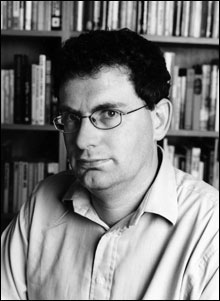
motivations in Dash’s book outshadows any
noir master’s contrivance. |
“Trial of the century” may be going a bit far. The almost contemporaneous judgment supporting millionaire Harry Thaw’s insanity-plea defense after his public assassination of architect Stanford White had far longer-lived impact on the 1900s. Yet the 1912 murder conviction of New York City police lieutenant Charles Becker deserves its innings. For one thing, he didn’t do it. Becker, a super-dirty cop who had indeed done many bad things, was framed by craven gang interests and railroaded to Sing Sing by an ambitious DA. More important, he ultimately was sentenced to death, and he became the only policeman ever executed in America.
Fascinating as the story is, this tale of mob hits and judicial miscarriage is merely the tantalizing underpinning for historian Mike Dash’s richly researched portrait of turn-of-the-century New York’s demi-monde. Satan’s Circus draws on published histories, personal diaries, court records, interview transcripts, and letters so exhaustively that even snippets of private conversations are 100 percent authenticated. The incredibly complex web of details and motivations that emerges outshadows any noir master’s contrivance.
The book’s central figure is neither Becker nor any of the saga’s cavalcade of gangsters and gamblers with colorful names like Dago Frank Cirofici, Kid Twist, Lefty Louie, Gyp the Blood, Bald Jack Rose, Dollar John, and Dopey Benny. Rather, the focus is the title real estate — Satan’s Circus, nickname for the lucrative vice-saturated blocks around Times Square, a neighborhood where the underworld really could, and did, “meet the elite.”
| Satan’s Circus: Murder, Vice, Police Corruption, And New York’s Trial Of The Century | By Mike Dash | Crown | 354 Pages | $24.95 |
The Lower West Side blocks between 23rd and 57th Streets didn’t have a monopoly on grafting, gambling, and prostitution. An intricate network of criminal activities and payoffs — administered by city-hall bosses, the political machines’ influential district captains, gang lords, and cops — funneled tainted cash to (mostly) the Democratic Party and divided much of Manhattan into turfs. The teeming fiefdoms were ruled by ethnocentric organized crime groups — chiefly Jews, Italians, Irish, and the less cohesive but cleaner-imaged Germans (who had the upper hand by dint of early arrival). In immigrant-flooded post–Gilded Age urban America, everyone and every institution — political, social, business, or criminal — was characterized first and most by ethnicity.The uneasy peace among struggling factions institutionalized civic vitiation and defined a power structure, hierarchy, economy, and social order as influential as anything above ground. Corruption’s near-total infiltration of the elected establishment created an extortion-funded alliance that worked to everyone’s short-term benefit.
It is against this fantastic backdrop — and a back-story scenario featuring cameos by such well-knowns as Tammany Hall’s Boss Tweed, publisher Joseph Pulitzer, novelist Stephen Crane, and critic Alexander Woollcott — that Becker’s fall from grace and ironic career finale were played out. At his high point, Becker, the German cop, was as much a criminal kingpin as any gangster. In the end, he was, somewhat cynically, promoted to head the city’s special anti-crime squad, and the consequent conflicts prompted the bad company he’d kept and his “respectable” bosses to conspire against him.
Dash’s depiction, which brings all of the above into ripping-yarn focus, is a tour de force of scholarship and entertaining storytelling that lets the 21st century in on the lawless details of how the 20th began. This is what history writing should be.